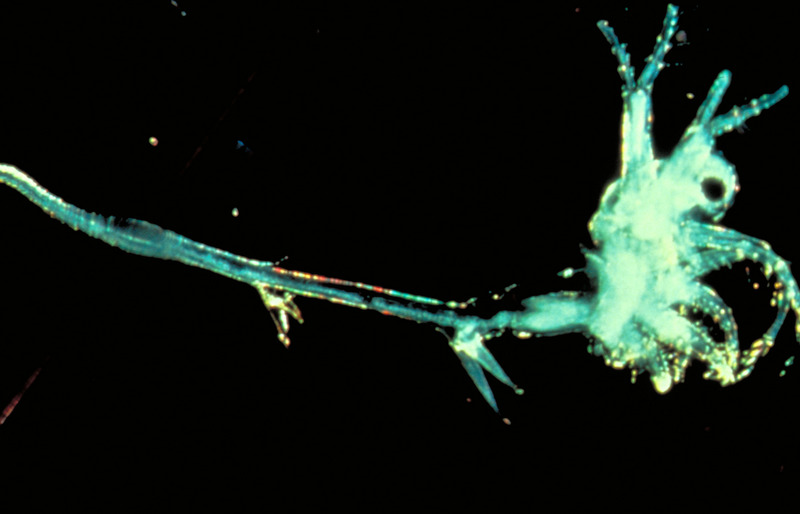Spiny Water Flea (Bythotrephes cederstroemi) - Wiki Bythotrephes cederstroemi
From Wikipedia, the free encyclopedia
Order: Cladocera
Family: Cercopagididae
[Photo] Spiny water flea, Unknown location. US Fish and Wildlife Service. Source: http://www.epa.gov/glnpo/image/viz_iss4.html
Bythotrephes cederstroemi, commonly known as the spiny water flea is a tiny aquatic crustacean less than an inch long. The spiny water flea is home in Great Britain and Northern Europe. The spiny water flea possesses a long spine with many barbs which protects it from predators and helps it to feed on other small organisms. Debate has formed as to the impact of species in non-native habitats where it has been accidentally introduced.
Description
Bythotrephes cederstroemi is easily recognizable with its spine averaging about 70% of its length. Adult spiny water fleas have three to four barbs on the spine while juveniles have only one pair. The spiny water flea has one large eye that is usually black or red. The spiny water flea possesses 4 pairs of legs, the first pair is used to catch prey. Bythotrephes also possess mandibles used for consumption of prey. It also possesses a pair of swimming antennae.
Diet
The spiny water flea consumes smaller planktonic organisms. Its diet consists mostly of zooplankton including "Daphnia" zooplankton, and smaller crustaceans. Bythotrephes cederstroemi can consume 10-15 prey organisms a day. The water flea may also eat other small organisms it comes across.
Reproduction
The spiny water flea can reproduce quickly with upwards to ten upspring every two weeks. Since the crustacean is only active from late spring to fall, eggs may lie dormant for the winter and hatch when the body of water has warmed up. The eggs are resilient to weather conditions allowing the eggs to survive extremely cold conditions. Though the majority of the water flea's population is female, it is capable of asexual reproduction as well as sexual reproduction.
Geographical range
The spiny water flea is native to northern Europe and Asia, and some parts of central Europe. However the water flea has spread in recent years to many areas throughout europe including some ports and inland lakes outside its natural range.
In the 1980s the crustacean has been found in Lake Huron and soon spread to the other Great Lakes and some inland lakes within the midwest including over 60 inland lakes in Ontario. The spiny water flea is thought to have been introduced by untreated ballast water from international boats. Concern has increased to the impact of this invasive species in the Great lakes region and other areas it might have been accidentally introduced. The flea has been accidentally introduced by means of bilge water and ballast water to the Great lakes. The spiny water flea may attach it to fishing line, downriggers, fishing nets, and other fishing equipment which has caused the spread of the water flea to inland lakes and rivers.
Impact in introduced areas
The crustacean competes with several fish including panfish and perch for prey. Smaller fish such as panfish and perch are not able to feed on the spiny water flea because of the barb the flea possesses. Only some larger species of fish are able to consume the water flea. The spiny water flea's diet consists mostly of Daphnia zooplankton, leading to competition with small and baby fish, and also with native water flea species. Daphnia zooplankton populations have declined in recent years though there is no conclusive evidence as to the cause.
http://en.wikipedia.org/wiki/Bythotrephes_cederstroemi
| The text in this page is based on the copyrighted Wikipedia article shown in above URL. It is used under the GNU Free Documentation License. You may redistribute it, verbatim or modified, providing that you comply with the terms of the GFDL. |
